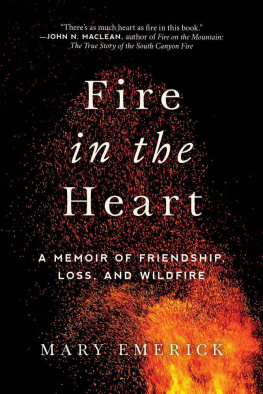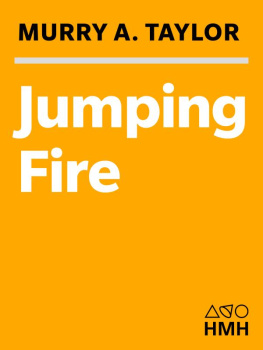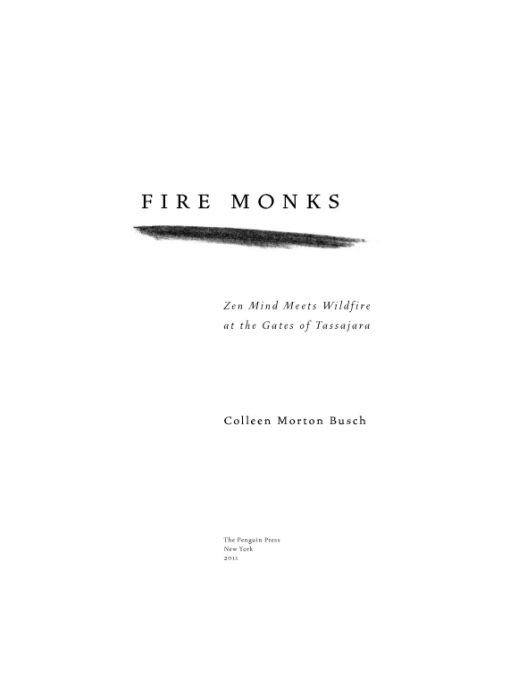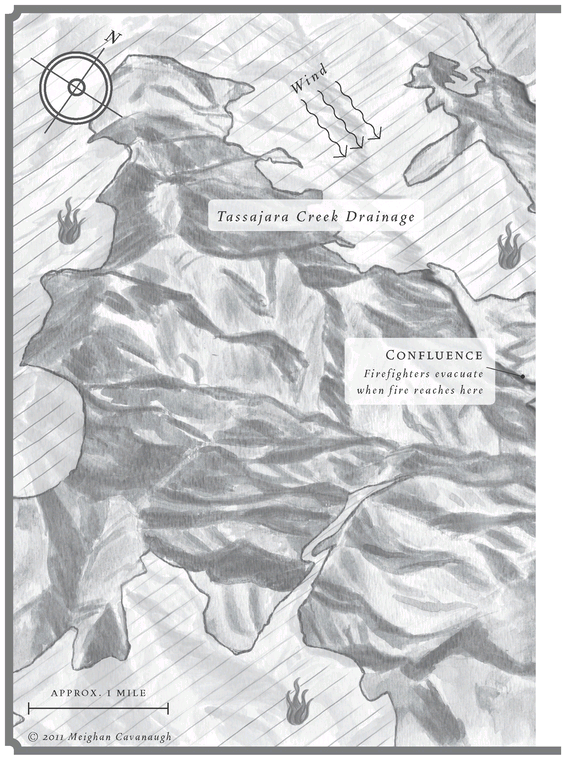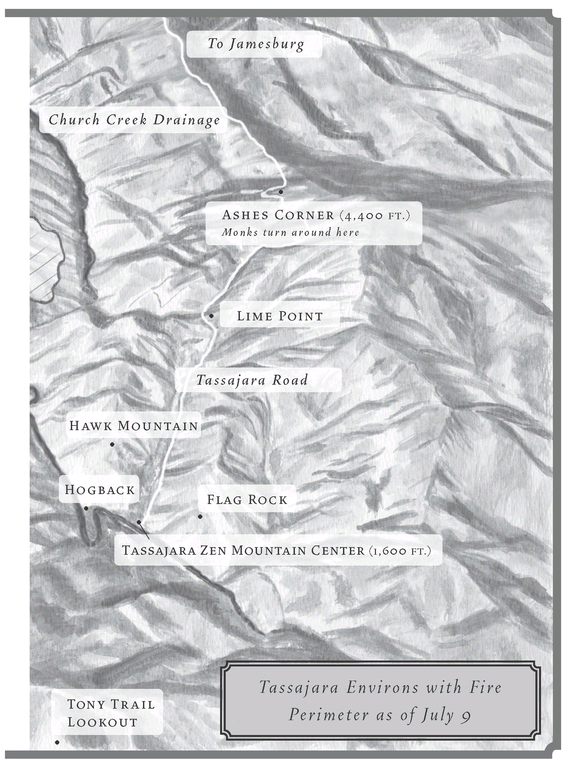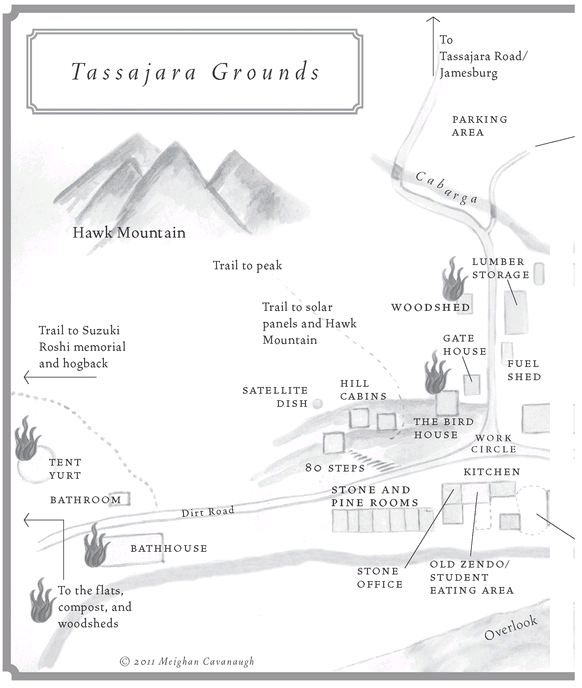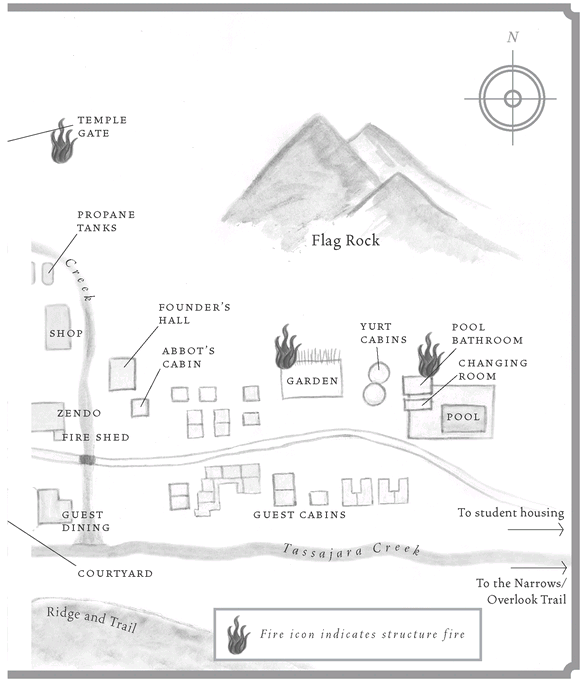Table of Contents
For John,
gatekeeper, gate crasher, holder of the keys
Fire is more than an ecological process or an environmental problem. It is a relationship.
STEPHEN J. PYNE, fire historian
CAST OF CHARACTERS
Tassajara Monks
STEVE STCKYSan Francisco Zen Center abbot
Dharma name: Daitsu Mygen, Greatly Pervading, Subtle Eye
DAVID ZIMMERMANdirector
Kansan Tetsuh, Perfection Mountain, Complete Surrender
MAKO VOELKELhead cook
Unzan Doshin, Cloud Mountain, Path of the Heart
GRAHAM ROSSplant manager
Unzan Etsudo, Cloud Mountain, Joyful Way
COLIN GIPSONhead of shop
Shikan Zenka, Determined to See, Completely Burned
SHUNDO DAVID HAYEformer resident, fire scout
Shundo Gennin, Way of the Fleet Steed, Manifesting Virtue
DEVIN PATELstudent fire marshal
Kakusei Yushin, Jewel Stillness, Fearless Heart
LESLIE JAMESsenior practice leader, Jamesburg resident
Sho Sai So Kan, Settle/Finish, Encourage, Original Mirror
JANE HIRSHFIELDformer resident, poet
So Kai Un Go, Source Servant, Cloud Abode
Firefighters
STUART CARLSONCAL FIRE station captain, Soquel Station, Santa
Cruz County
JACK FROGGATTKern County Fire Department battalion chief
Basin Complex fire branch director
GEORGE HAINESCAL FIRE unit chief, San BenitoMonterey Unit
PROLOGUE
On June 21, 2008, lightning strikes from one end of drought-dry California to the other ignited more than two thousand wildfires in what became known as the lightning siege. The fires stretched from the Trinity Alps in the north to Santa Barbara in the south. One of the blazes turned toward Tassajara Zen Mountain Center, in the Ventana Wilderness near Big Sur. For weeks the resident monks prepared for the fires arrival, committed to staying to defend the monastery despite repeated orders to leave.
If you lived on the West Coast, you knew about the fires. If you lived in California, you smelled the smoke. The situation at Tassajara was featured in the national news. Connections to the monastery, famous for its hot springs, food, and peaceful environs, extend around the world. Even those whod never been to Tassajara or heard of it before were intrigued by the seemingly paradoxical image of a fire monk. Suddenly, people who ordinarily spent a good deal of time sitting cross-legged in front of a wall faced a situation that required decisive action. What did that look like? And how could sitting still and doing nothing prepare you to act, and to act fast?
As a Zen student and regular visitor to Tassajara over the past ten years, I followed the fire closely. On the day it swept through the monastery, I was camping in Oregon, outside the band of smoke drifting north from California. As soon as I read Tassajara director David Zimmermans account of the fires arrival, I wanted to tell this storyfrom as close in as possible, but also with a wide lens. What was it like to meet a wildfire with minimal training in firefighting but years of Zen practice to guide you? I believed others might benefit from knowing, the fire being a perfect metaphor for anything that comes uninvited and threatens to hurt us or the people and places we love.
The word Zen is often used as a catchall synonym for paradox, simultaneously evoking the simple and the unfathomable. In Fire Monks, I wanted to portray Zen in all of its true complexity and relevance, as a continuous practice, a way of life that cultivates a particular kind of fearlessness whether or not theres a wildfire at the gate.
To write the book, I relied on official reports and logs, news coverage, written accounts and public talks, the Sitting with Fire blog created during the lead-up to the fires arrival, and my own interviewsmore than one hundred taped hourswith residents of Tassajara. I used first names in the pages that follow to distinguish the storys main characters; for practical reasons, many people I spoke with are named not in the body of the story but in the endnotes.
Over a period of two years after the fire, I made many trips to Tassajara, some during the summer guest season, others during the closed fall and winter training periods. Tassajara during a practice period and Tassajara during guest season are two sides of the same coin. Practice is always happening thereeven in the summer months when there are guests who may have come simply for the hot springs and lavish vegetarian foodbut it can look quite different depending on the season.
In a formal training period, practice looks like this: a wake-up bell at three fifty a.m., six periods of meditation, from forty minutes to an hour in length, interspersed with periods of work and study and occasional lectures. Simple meals are eaten in the zendo (meditation hall) at ones seat, in three bowls, nested and wrapped in cloths when not in use. There is about an hour and a half in the late afternoon for exercise and bathing. The day ends around nine p.m. after the last period of zazen, or meditation. On designated workdays and personal days, the schedule is slightly more forgiving.
In the summer guest season, a student runs up and down the paths at Tassajara swinging the wake-up bell and calling the resident community to meditation a full hour and a half later, at five fifteen a.m. The summer community consists of both long-term, year-round residents and summer work practice students often new to Zen. Though the zazen schedule is much lighter, the community works for most of each day to take care of Tassajara and its guests, mostly in silence. Whether its tending to the altars, serving meals, or washing dishes, this work is considered an essential part of practicenot separate from the practice of meditation.
My first trip to Tassajara for Fire Monks took place during the winter practice period in November 2008, four months after the fire. David greeted me at the gate. When I commented on the smoky smell still in the air and the paths littered with leaves, he said, Thats Tassajara in the fall. Id been there only during the summer, for guest practicemeditating and working with the community in the morning, relaxing as a guest in the afternoon.
During the books writing, I witnessed Tassajaras recovery. Wildflowers bloomed on barren hillsides. Grasses sprouted, ferns unfurled, bright green shoots broke through the soil at the bases of charred tree trunks. The road became an obstacle course of potholes, runoff, rockfalls, and downed trees, until the county rehabilitated and graded it. New buildings gradually replaced burned ones. A community tested by a crisis continued to practice together and to examine their experience for whatever truths it might hold. Memories faded and then reappeared when I asked questions or when smoke hovered over the valley from a new wildfire in the distance.




